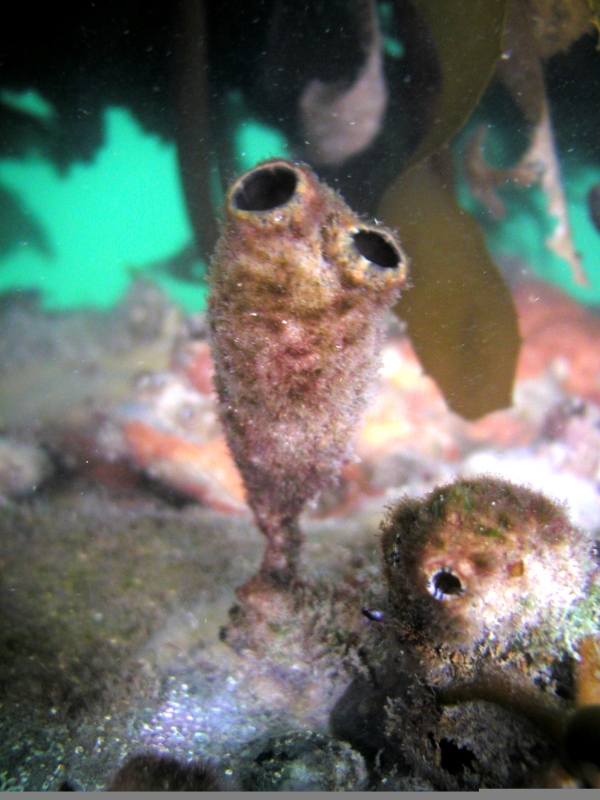When you are at the beach or harbours this summer, don't be surprised if you see sea squirts - marine animals we commonly see attached to rocks and wharf piles that have two siphons on the top of their bodies, one to draw in water and the other to expel it. When disturbed, sea squirts contract their siphons, expelling streams of water—hence their name.
NIWA has created a new, colourful and intuitive guide to sea squirts found around New Zealand coasts and ports. Packed with photographs of 28 species, the guide is geared towards easy identification of sea squirts in the field and is a useful tool for keen underwater observers.
The guide includes some of the recently arrived invasive species of sea squirt that have colonised our ports and harbours, as well as many benign native species. It covers species we're already aware of, so if you spot what you believe is a new one, please let the Ministry for Primary Industries know on their freephone 0800 80 99 66. Checks can be made to make sure it is not likely to be troublesome.
Sea squirts (ascidians) are amongst the most commonly found fouling animals in ports and harbours around the world, including New Zealand's. They settle and grow in great abundance on submerged structures such as wharf piles, seawalls, ship hulls and aquaculture structures. In some countries, they are eaten by humans.
The guide gives important information about each species: its appearance, whether it is native, its habitat, how common it is, its distribution around New Zealand, and what threats (if any) it poses to New Zealand ecology and aquaculture.
While most native ascidian species are found in low numbers in intertidal and subtidal environments around New Zealand, non-indigenous species can be highly successful, often reaching densities that preclude other species. The potential impact of some of these sea squirt species on the shellfish aquaculture industry in particular, can be serious.
Sea squirts have abundant, highly mobile larvae that settle and grow quickly into adults, competing with other species for food and space. Some species are able to replicate themselves asexually, which causes very rapid growth of the colony. Rapidly growing sea squirt colonies, such as Didemnum vexillum, can overgrow and smother mussels. Pyura praeputialis forms dense mats that alter natural habitats used by other species.
NIWA scientist Mike Page says, "We designed the guide because people want to know what they are, particularly when they are on the hunt for non-indigenous and invasive organisms. Therefore the guide will be useful for the Ministry for Primary Industries, Department of Conservation, regional councils, district councils, schools, universities and port authorities."
The guide contains easy-to-follow diagrams of sea squirt biology and flowcharts for species identification. It uses clear and user-friendly icons for each species to show key information about its habits and characteristics.
The sea squirt species are illustrated with high-quality images of the animals in their habitat.
"As far as possible, we have used identifying features that can be seen with the unaided eye or a magnifying glass, and language that is non-technical," says Page.
The guide is dynamic and new species will be added as they are discovered. The guide will be updated on NIWA's website : Seasquirts common to the ports and harbours of New Zealand.
This research was funded by the Ministry of Business, Innovation and Employment.
Notes
See photos on the right hand side for images of the organisms
Eudistoma elongatum
The guide includes some recently arrived threats to biosecurity, including Eudistoma elongatum, which causes fouling on cultured oyster racks.
It has long cylindrical pendulous cream coloured colonies, tapering to a stalk. Eudistoma elongatum is an Australian native sea squirt, which forms large colonies or groups that attach to hard surfaces.
Eudistoma elongatum has been reported on several marine farms on Northland's east coast - at Houhora and Parengarenga harbours, as well as in Waikare Inlet, Orongo and Paroa Bays within the Bay of Islands. It has also been reported from rocks near the entrance to the inlet at Waikino Creek, Okiato Point and Paihia in the Bay of Islands.
It looks like clusters of white or cream coloured tubes or 'sausages'. Each rope or 'sausage' is actually a cylinder or tunic, containing numerous small individuals. They can be 5-30 cm long, but in some instances up to 1.5m, and 5-20mm in diameter.
The white tunics contain many small individual organisms and can sometimes appear orange flecked due to the bright orange colour of larvae within them.
This type of sea squirt is generally found in muddy bottomed tidal habitats and on man-made structures such as wharf piles, or on aquaculture equipment.
Styela clava
Styela clava (the clubbed tunicate sea squirt) is found in northern New Zealand waters, Nelson and Lyttelton harbours. It was declared an unwanted organism under the Biosecurity Act 1993.
It has a short stalk, with short siphons close together at the top of the stalk with warty swellings around the siphons.
Styela clava was identified in the Viaduct Harbour, Auckland in September 2005 and the Port of Lyttelton, Christchurch, the following month. Until then, Styela clava was not known in New Zealand. It probably got here by arriving on the hull or internal recesses of international vessels visiting New Zealand.
Pyura praeputialis
Pyura praeputialis forms dense populations or mats and has been found growing on rocks in a number of locations in the far north of New Zealand. Its impact in the New Zealand environment is not yet known. There is, however, concern that should it spread, it could displace important native New Zealand species, including green-lipped mussels. There are also concerns Pyura could be inadvertently spread to marine farms outside the Far North region.




